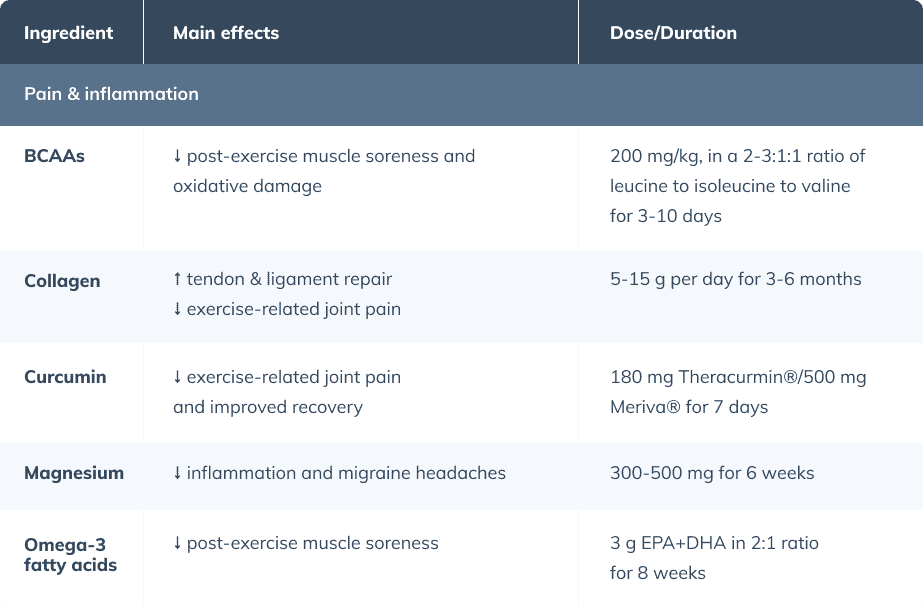Musculoskeletal Health: Exercise Pain and Recovery
November 17, 2021
Protocol development in integrative medicine is not typically a simple process. Individuals require individualized care, and what works for one patient may not work for another.
To establish these protocols, we first developed a Rating Scale that could be used to discern the rigor of evidence supporting a specific nutrient’s therapeutic effect.
The following protocols were developed using only A through C-quality evidence.
Many dietary supplements are marketed to athletes for purposes that extend beyond the classic ergogenic aid definitions. Examples include supplements that help to reduce exercise-induced pain & inflammation and improve recovery.
During and especially after athletic activity, the body has a number of responses in order to help it recover and adapt. Many of these responses involve some level of local inflammation and muscle soreness that peaks within 24 to 48 hours after the exercise, usually referred to collectively as delayed onset muscle soreness (DOMS). These processes may contribute to various functional deficits such as reduced strength and/or range of motion. (Davis 2007)
The ingredients selected for this protocol may help improve symptoms of exercise-related pain and aid in recovery. For example, branched-chain amino acids (BCAAs) may provide extra quantities of certain amino acids that may help to reduce markers of exercise-related damage. (Khemtong 2021) Collagen acts to provide strength and elasticity to connective tissues. (Dressler 2018) Curcumin reduces many inflammatory markers and may shorten recovery time from exercise. (Fang 2020)(Suhett 2021) Magnesium may reduce inflammation and cortisol levels and improve immunological function, all aiding in recovery. Finally, omega-3 fatty acids have effects on cyclooxygenase-2 expression and the metabolism of arachidonic acid. (Ochi 2018)
 Overview of ingredients for exercise-induced pain and recovery
Overview of ingredients for exercise-induced pain and recovery
~200 mg/kg/day (i.e., 14 g for a 70 kg individual) for 3-10 days (Fouré 2017) 2-3:1:1 ratio of leucine:isoleucine:valine (Salinas-Garcia 2014)
5 to 15 g per day for 3 months. (Clark 2008)(Zdzieblik 2017)(Dressler 2018)(Praet 2019)(Shaw 2017)
 Address exercise pain and recovery with the evidence-based ingredients in this protocol.
Address exercise pain and recovery with the evidence-based ingredients in this protocol.
180 mg Theracurmin®/500 mg Meriva® for 7 days (Suhett 2021)
300 to 500 mg per day for 7 weeks (Heffernan 2019)
3 g of EPA+DHA in 2:1 ratio for 8 weeks (Ochi 2018)

This site is intended solely as an informational reference tool for practicing healthcare professionals. The content provided is not intended to be for medical diagnosis or treatment, is not a substitute for your professional judgment, and is not meant to provide you with medical or professional advice. You should evaluate and independently confirm the appropriateness of the content provided, and you should rely on your experience and judgment and other available resources when applying the provided content to an actual patient care situation. While content has been obtained from sources believed to be reliable, we cannot and do not guarantee the accuracy, validity, timeliness, or completeness of the content.